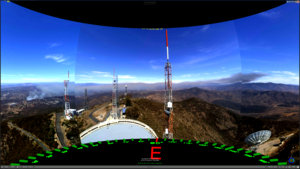The High Performance Wireless Research and Education Network (HPWREN), a University of California San Diego partnership project led by the San Diego Supercomputer Center and the Scripps Institution of Oceanography's Institute of Geophysics and Planetary Physics, supports Internet-data applications in the research, education, and public safety realms.
HPWREN functions as a collaborative, Internet-connected cyberinfrastructure. The project supports a high-bandwidth wireless backbone and access data network in San Diego, Riverside, and Imperial counties in areas that are typically not well-served by other technologies to reach the Internet. This includes backbone locations, typically sited on mountain tops, to connect often hard-to-reach areas in the remote Southern California back country.
Recent Image

The image shows a screenshot of part of a panoramic view of the Steele Fire on 9 July 2025, then stretching across three cameras, as seen from HPWREN cameras on Lyons Peak. The full 360 degree panorama views is a new feature in HPWREN's camera user interface, and can be applied to both real-time and archived data. It looks even better on VR/AR devices.



